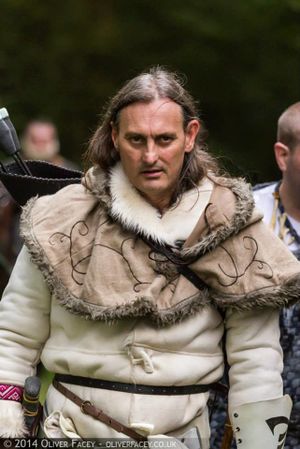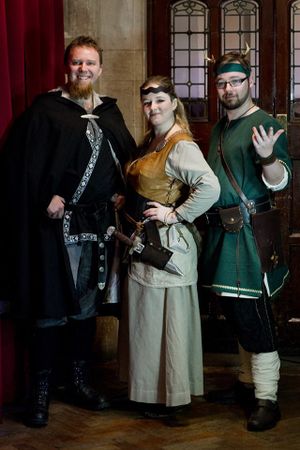Wintermark people
No edit summary |
m (→Sample names) |
||
| (74 intermediate revisions by 9 users not shown) | |||
| Line 1: | Line 1: | ||
{{CaptionedImage|file= | {{CaptionedImage|file=Wintermark Clothing.jpg|align=right|width=300}} | ||
The | The Winterfolk were once three separate peoples: the [[Kallavesi]], the [[Steinr]] and the [[Suaq]]. Although they unified years before they joined the Empire, they preserve the heritage that made each tradition strong. Which tradition you follow is not an accident of birth but a choice made by each Winterfolk child as they reach maturity. Just as one might be born a peasant and rise to become a Thane, so someone can be born to Steinr family and leave to follow the path of a Kallavesi mystic or journey with the Suaq as a scout. Children gravitate towards whichever tradition calls most strongly to them as they come of age. | ||
All three traditions are equally respected; they are all crucial to the survival of the nation. Although a single tradition predominates in each territory of Wintermark – this is a consequence of landscape and history – most communities include members of all three. They refer to themselves as Winterfolk, especially when talking to outsiders. They no longer consider themselves three peoples; they are one people, but with three traditions. | |||
Many Winterfolk maintain the old belief in the [[Wintermark Culture and Customs#Skein|Skein]] which says that when one decides to do something, one should be absolutely committed. Vacillation is anathema as is trying to go back on one's skein by trying to undo a decision one has made. When they hunt monsters across the icy wastes, they seek to kill all of them. When they design a fortress or a suit of armour, they strive to make it impregnable. When they go to war, they are prepared to die for their cause. | |||
They judge people not by the company they keep or by their words, but by the things they do. They live their lives to the full, throwing themselves into whatever they are doing with gusto. They are generous in triumph but selfish in defeat. The mark of a Wintermark hero is that they take personal responsibility for their failings but they share their victories with everyone. The more people involved in a heroic deed, the more heroic it is seen to be. Whenever the Scops tell a tale of a battle, everyone who fought at that battle stands a little taller, even if their specific deeds are not recounted. | |||
Many Winterfolk | All Winterfolk admire personal [[heroism]]. They relish challenges as an opportunity to prove themselves. Battle is an obvious opportunity to show one's worth, but they also recognise the challenges that are overcome with cunning or wisdom. Whether triumph is won by force of arms, imagination and cunning or wise and profound insight does not matter to the Winterfolk. What counts is how significant and notable the triumph was and how many benefit as a result of the deed. Winterfolk heroes are those whose prowess and noble qualities serve or inspire others. | ||
{{CaptionedImage|file=KiviuqSnowEagle.jpg|align=right|caption=Many Winterfolk maintain the belief in the [[Wintermark Culture and Customs#Skein|Skein]]|title=Survival. Loyalty to friends. Defence of Wintermark. A good death.|width=300}} | |||
While the stereotypical Winterfolk crafter is often thought of as a weapon or armour smith, they are also known for their expertise in civil and military engineering, their construction of great fortresses and other defensive structures and their delicately engraved jewellery. The Winterfolk prize individuality, not just as people, but in the things they do and the things they make. Winterfolk crafters take immense pride in incorporating complex [[runes]] into the things they create. The Winterfolk delight in this act of creation; they enjoy making beautiful and unique things, whether it be a torc, a weapon, or a poem. | |||
==Names== | |||
Winterfolk names are primarily Saxon and Finnish in flavour. | |||
===Sample names=== | |||
Aarne, Agatha, Alric, Anja, Burmoth, Cynestan, Dunstan, Eadric, Eawyn, Edith, Elina, Eomer, Emma, Esa, Gytha, Inga, Kaisa, Kye, Lyydia, Maethild, Marko, Needa, Oswald, Reet, Ricola, Siward, Suvi, Theodric, Topi, Urho, Ville, Wulfric, Wynflaed, Ymma. | |||
N.B. Whilst some names are inspired by real world names which may be given to specific genders, Empire is a gender blind setting and people of any gender choose any name they like that is appropriate to their nation. | |||
When they are born Winterfolk take their second names from the thane's hall to which they belong, (which in turn will have been named after its founder) or less commonly they may take the name of one of their parents. In either case, the name is adjusted to make the name flow. | |||
The Winterfolk strive to commit deeds worthy of a name, to earn a name. This name is bestowed by the scops and is a word or phrase that reflects the character's achievements. You can create a character who has already achieved their name or one that is still looking to earn their name. | |||
* ''{given name} {thane's hall}ing'' e.g. Alric Marking (Alric of Marko's Hall), Reet Ceorling (Reet of Ceorl's Hall). | |||
* ''{given name} {parent's name}sson'', ''{given name} {parent's name}sdottir'' or ''{given name} {parent's name}sbarn'' e.g. Hrothgar Arnesson, Adla Runasdottir, Inga Siwardsbarn | |||
* ''{nickname and given name}'' e.g. Wulfric the Bear, Wise Lyydia, Black Dow. | |||
* | |||
===Naming resources=== | |||
* [http://www.regia.org/members/names.htm Saxon names] | |||
* [http://www.behindthename.com/names/usage/finnish Finnish names] | |||
{{Wintermark Links}} | |||
Latest revision as of 07:29, 4 May 2023
The Winterfolk were once three separate peoples: the Kallavesi, the Steinr and the Suaq. Although they unified years before they joined the Empire, they preserve the heritage that made each tradition strong. Which tradition you follow is not an accident of birth but a choice made by each Winterfolk child as they reach maturity. Just as one might be born a peasant and rise to become a Thane, so someone can be born to Steinr family and leave to follow the path of a Kallavesi mystic or journey with the Suaq as a scout. Children gravitate towards whichever tradition calls most strongly to them as they come of age.
All three traditions are equally respected; they are all crucial to the survival of the nation. Although a single tradition predominates in each territory of Wintermark – this is a consequence of landscape and history – most communities include members of all three. They refer to themselves as Winterfolk, especially when talking to outsiders. They no longer consider themselves three peoples; they are one people, but with three traditions.
Many Winterfolk maintain the old belief in the Skein which says that when one decides to do something, one should be absolutely committed. Vacillation is anathema as is trying to go back on one's skein by trying to undo a decision one has made. When they hunt monsters across the icy wastes, they seek to kill all of them. When they design a fortress or a suit of armour, they strive to make it impregnable. When they go to war, they are prepared to die for their cause.
They judge people not by the company they keep or by their words, but by the things they do. They live their lives to the full, throwing themselves into whatever they are doing with gusto. They are generous in triumph but selfish in defeat. The mark of a Wintermark hero is that they take personal responsibility for their failings but they share their victories with everyone. The more people involved in a heroic deed, the more heroic it is seen to be. Whenever the Scops tell a tale of a battle, everyone who fought at that battle stands a little taller, even if their specific deeds are not recounted.
All Winterfolk admire personal heroism. They relish challenges as an opportunity to prove themselves. Battle is an obvious opportunity to show one's worth, but they also recognise the challenges that are overcome with cunning or wisdom. Whether triumph is won by force of arms, imagination and cunning or wise and profound insight does not matter to the Winterfolk. What counts is how significant and notable the triumph was and how many benefit as a result of the deed. Winterfolk heroes are those whose prowess and noble qualities serve or inspire others.

While the stereotypical Winterfolk crafter is often thought of as a weapon or armour smith, they are also known for their expertise in civil and military engineering, their construction of great fortresses and other defensive structures and their delicately engraved jewellery. The Winterfolk prize individuality, not just as people, but in the things they do and the things they make. Winterfolk crafters take immense pride in incorporating complex runes into the things they create. The Winterfolk delight in this act of creation; they enjoy making beautiful and unique things, whether it be a torc, a weapon, or a poem.
Names
Winterfolk names are primarily Saxon and Finnish in flavour.
Sample names
Aarne, Agatha, Alric, Anja, Burmoth, Cynestan, Dunstan, Eadric, Eawyn, Edith, Elina, Eomer, Emma, Esa, Gytha, Inga, Kaisa, Kye, Lyydia, Maethild, Marko, Needa, Oswald, Reet, Ricola, Siward, Suvi, Theodric, Topi, Urho, Ville, Wulfric, Wynflaed, Ymma.
N.B. Whilst some names are inspired by real world names which may be given to specific genders, Empire is a gender blind setting and people of any gender choose any name they like that is appropriate to their nation.
When they are born Winterfolk take their second names from the thane's hall to which they belong, (which in turn will have been named after its founder) or less commonly they may take the name of one of their parents. In either case, the name is adjusted to make the name flow.
The Winterfolk strive to commit deeds worthy of a name, to earn a name. This name is bestowed by the scops and is a word or phrase that reflects the character's achievements. You can create a character who has already achieved their name or one that is still looking to earn their name.
- {given name} {thane's hall}ing e.g. Alric Marking (Alric of Marko's Hall), Reet Ceorling (Reet of Ceorl's Hall).
- {given name} {parent's name}sson, {given name} {parent's name}sdottir or {given name} {parent's name}sbarn e.g. Hrothgar Arnesson, Adla Runasdottir, Inga Siwardsbarn
- {nickname and given name} e.g. Wulfric the Bear, Wise Lyydia, Black Dow.
Naming resources
Further Reading
Core Brief
Further Reading
